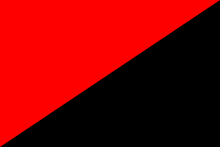May 1968 events in France
| May 1968 events in France | |||
|---|---|---|---|
| Part of Protests of 1968 | |||
 Barricades in Bordeaux in May 1968. | |||
| Date |
2 May – 23 June 1968 (1 month and 3 weeks) | ||
| Location | France | ||
| Methods | Occupations, wildcat strikes, general strikes | ||
| Resulted in | Snap legislative election | ||
| Parties to the civil conflict | |||
|
| |||
| Lead figures | |||
|
| |||
The volatile period of civil unrest in France during May 1968 was punctuated by demonstrations and massive general strikes as well as the occupation of universities and factories across France. At the height of its fervor, it brought the entire economy of France to a virtual halt.[1] The protests reached such a point that political leaders feared civil war or revolution; the national government itself momentarily ceased to function after President Charles de Gaulle secretly fled France for a few hours. The protests spurred an artistic movement, with songs, imaginative graffiti, posters, and slogans.[2][3]
"May 68" affected French society for decades afterward. It is considered to this day as a cultural, social and moral turning point in the history of the country. As Alain Geismar—one of the leaders of the time—later pointed out, the movement succeeded "as a social revolution, not as a political one".[4]
The unrest began with a series of student occupation protests against capitalism, consumerism, American imperialism and traditional institutions, values and order. It then spread to factories with strikes involving 11 million workers, more than 22% of the total population of France at the time, for two continuous weeks.[1] The movement was characterized by its spontaneous and de-centralized wildcat disposition; this created contrast and sometimes even conflict between itself and the establishment, trade unions and workers' parties.[1] It was the largest general strike ever attempted in France, and the first nationwide wildcat general strike.[1]
The student occupations and wildcat general strikes initiated across France were met with forceful confrontation by university administrators and police. The de Gaulle administration's attempts to quell those strikes by police action only inflamed the situation further, leading to street battles with the police in Paris's Latin Quarter, followed by the spread of general strikes and occupations throughout France. De Gaulle fled to a French military base in Germany, and after returning dissolved the National Assembly, and called for new parliamentary elections for 23 June 1968. Violence evaporated almost as quickly as it arose. Workers went back to their jobs, and when the elections were finally held in June, the Gaullist party emerged even stronger than before.
Events before May
In February 1968, the French Communists and French Socialists formed an electoral alliance. Communists had long supported Socialist candidates in elections, but in the "February Declaration" the two parties agreed to attempt to form a joint government to replace President Charles de Gaulle and his Gaullist Party.[5]
On 22 March far-left groups, a small number of prominent poets and musicians, and 150 students occupied an administration building at Paris University at Nanterre and held a meeting in the university council room dealing with class discrimination in French society and the political bureaucracy that controlled the university's funding. The university's administration called the police, who surrounded the university. After the publication of their wishes, the students left the building without any trouble. After this first record some leaders of what was named the "Movement of 22 March" were called together by the disciplinary committee of the university.
Events of May
| Part of the Politics series on |
| Students' rights |
|---|
|
Concepts / Theory
|
|
Student strikes
Following months of conflicts between students and authorities at the Nanterre campus of the University of Paris (now Paris Nanterre University), the administration shut down the university on 2 May 1968.[6] Students at the Sorbonne campus of the University of Paris (today Sorbonne University) in Paris met on 3 May to protest against the closure and the threatened expulsion of several students at Nanterre.[7] On Monday, 6 May, the national student union, the Union Nationale des Étudiants de France (UNEF)—still the largest student union in France today—and the union of university teachers called a march to protest against the police invasion of Sorbonne. More than 20,000 students, teachers and supporters marched towards the Sorbonne, still sealed off by the police, who charged, wielding their batons, as soon as the marchers approached. While the crowd dispersed, some began to create barricades out of whatever was at hand, while others threw paving stones, forcing the police to retreat for a time. The police then responded with tear gas and charged the crowd again. Hundreds more students were arrested.
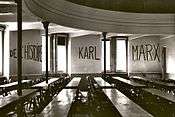
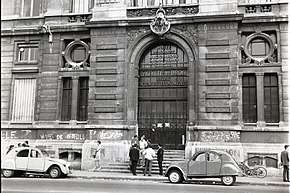
High school student unions spoke in support of the riots on 6 May. The next day, they joined the students, teachers and increasing numbers of young workers who gathered at the Arc de Triomphe to demand that:
- All criminal charges against arrested students be dropped,
- the police leave the university, and
- the authorities reopen Nanterre and Sorbonne.
Negotiations broke down, and students returned to their campuses after a false report that the government had agreed to reopen them, only to discover the police still occupying the schools. This led to a near revolutionary fervor among the students.
On Friday, 10 May, another huge crowd congregated on the Rive Gauche. When the Compagnies Républicaines de Sécurité again blocked them from crossing the river, the crowd again threw up barricades, which the police then attacked at 2:15 in the morning after negotiations once again floundered. The confrontation, which produced hundreds of arrests and injuries, lasted until dawn of the following day. The events were broadcast on radio as they occurred and the aftermath was shown on television the following day. Allegations were made that the police had participated, through agents provocateurs, in the riots, by burning cars and throwing Molotov cocktails.[8]
The government's heavy-handed reaction brought on a wave of sympathy for the strikers. Many of the nation's more mainstream singers and poets joined after the heavy-handed police brutality came to light. American artists also began voicing support of the strikers. The major left union federations, the Confédération Générale du Travail (CGT) and the Force Ouvrière (CGT-FO), called a one-day general strike and demonstration for Monday, 13 May.
Well over a million people marched through Paris on that day; the police stayed largely out of sight. Prime Minister Georges Pompidou personally announced the release of the prisoners and the reopening of the Sorbonne. However, the surge of strikes did not recede. Instead, the protesters became even more active.
When the Sorbonne reopened, students occupied it and declared it an autonomous "people's university". Public opinion at first supported the students, but quickly turned against them after their leaders, invited to appear on national television, "behaved like irresponsible utopianists who wanted to destroy the 'consumer society.'"[9] Nonetheless, in the weeks that followed, approximately 401 popular action committees were set up in Paris and elsewhere to take up grievances against the government and French society, including the Sorbonne Occupation Committee.
Workers join the students
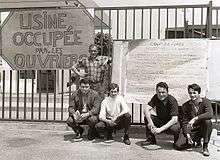
In the following days, workers began occupying factories, starting with a sit-down strike at the Sud Aviation plant near the city of Nantes on 14 May, then another strike at a Renault parts plant near Rouen, which spread to the Renault manufacturing complexes at Flins in the Seine Valley and the Paris suburb of Boulogne-Billancourt. Workers had occupied roughly fifty factories by 16 May, and 200,000 were on strike by 17 May. That figure snowballed to two million workers on strike the following day and then ten million, or roughly two-thirds of the French workforce, on strike the following week.
These strikes were not led by the union movement; on the contrary, the CGT tried to contain this spontaneous outbreak of militancy by channeling it into a struggle for higher wages and other economic demands. Workers put forward a broader, more political and more radical agenda, demanding the ousting of the government and President de Gaulle and attempting, in some cases, to run their factories. When the trade union leadership negotiated a 35% increase in the minimum wage, a 7% wage increase for other workers, and half normal pay for the time on strike with the major employers' associations, the workers occupying their factories refused to return to work and jeered their union leaders.[10][11] In fact, in the May '68 movement there was a lot of "anti-unionist euphoria,"[12] against the mainstream unions, the CGT, FO and CFDT, that were more willing to compromise with the powers that be than enact the will of the base.[1]
On 25 May and 26 May, the Grenelle agreements were conducted at the Ministry of Social Affairs. They provided for an increase of the minimum wage by 25% and of average salaries by 10%. These offers were rejected, and the strike went on. The working class and top intellectuals were joining in solidarity for a major change in workers' rights.
On 27 May, the meeting of the UNEF, the most outstanding of the events of May 1968, proceeded and gathered 30,000 to 50,000 people in the Stade Sebastien Charlety. The meeting was extremely militant with speakers demanding the government be overthrown and elections held.
The Socialists saw an opportunity to act as a compromise between de Gaulle and the Communists. On 28 May, François Mitterrand of the Federation of the Democratic and Socialist Left declared that "there is no more state" and stated that he was ready to form a new government. He had received a surprisingly high 45% of the vote in the 1965 presidential election. On 29 May, Pierre Mendès France also stated that he was ready to form a new government; unlike Mitterrand he was willing to include the Communists. Although the Socialists did not have the Communists' ability to form large street demonstrations, they had more than 20% of the country's support.[9][5]
De Gaulle flees
On the morning of 29 May, de Gaulle postponed the meeting of the Council of Ministers scheduled for that day and secretly removed his personal papers from Élysée Palace. He told his son-in-law Alain de Boissieu, "I do not want to give them a chance to attack the Élysée. It would be regrettable if blood were shed in my personal defense. I have decided to leave: nobody attacks an empty palace." De Gaulle refused Pompidou's request that he dissolve the National Assembly as he believed that their party, the Gaullists, would lose the resulting election. At 11:00 a.m., he told Pompidou, "I am the past; you are the future; I embrace you."[9]
The government announced that de Gaulle was going to his country home in Colombey-les-Deux-Églises before returning the next day, and rumors spread that he would prepare his resignation speech there. The presidential helicopter did not arrive in Colombey, however, and de Gaulle had told no one in the government where he was going. For more than six hours the world did not know where the French president was.[13] The canceling of the ministerial meeting, and the president's mysterious disappearance, stunned the French[9] including Pompidou, who shouted, "He has fled the country!"[14]
The national government had effectively ceased to function. Édouard Balladur later wrote that as prime minister, Pompidou "by himself was the whole government" as most officials were "an incoherent group of confabulators" who believed that revolution would soon occur. A friend of the prime minister offered him a weapon, saying, "You will need it"; Pompidou advised him to go home. One official reportedly began burning documents, while another asked an aide how far they could flee by automobile should revolutionaries seize fuel supplies. Withdrawing money from banks became difficult, gasoline for private automobiles was unavailable, and some people tried to obtain private planes or fake national identity cards.[9]
Pompidou unsuccessfully requested that military radar be used to follow de Gaulle's two helicopters, but soon learned that he had gone to the headquarters of the French military in Germany, in Baden-Baden, to meet General Jacques Massu. Massu persuaded the discouraged de Gaulle to return to France; now knowing that he had the military's support, de Gaulle rescheduled the meeting of the Council of Ministers for the next day, 30 May,[9] and returned to Colombey by 6:00 p.m.[13] His wife Yvonne gave the family jewels to their son and daughter-in-law—who stayed in Baden for a few more days—for safekeeping, however, indicating that the de Gaulles still considered Germany a possible refuge. Massu kept as a state secret de Gaulle's loss of confidence until others disclosed it in 1982; until then most observers believed that his disappearance was intended to remind the French people of what they might lose. Although the disappearance was real and not intended as motivation, it indeed had such an effect on France.[9]
On 30 May, 400,000 to 500,000 protesters (many more than the 50,000 the police were expecting) led by the CGT marched through Paris, chanting: "Adieu, de Gaulle!" ("Farewell, de Gaulle!"). Maurice Grimaud, head of the Paris police, played a key role in avoiding revolution by both speaking to and spying on the revolutionaries, and by carefully avoiding the use of force. While Communist leaders later denied that they had planned an armed uprising, and extreme militants only comprised 2% of the populace, they had overestimated de Gaulle's strength as shown by his escape to Germany.[9] (One scholar, otherwise skeptical of the French Communists' willingness to maintain democracy after forming a government, has claimed that the "moderate, nonviolent and essentially antirevolutionary" Communists opposed revolution because they sincerely believed that the party must come to power through legal elections, not armed conflict that might provoke harsh repression from political opponents.)[5]
The movement was largely centered around the Paris metropolitan area, and not elsewhere. Had the rebellion occupied key public buildings in Paris, the government would have had to use force to retake them. The resulting casualties could have incited a revolution, with the military moving from the provinces to retake Paris as in 1871. Minister of Defence Pierre Messmer and Chief of the Defence Staff Michel Fourquet prepared for such an action, and Pompidou had ordered tanks to Issy-les-Moulineaux.[9] While the military was free of revolutionary sentiment, using an army mostly of conscripts the same age as the revolutionaries would have been very dangerous for the government.[5][13] A survey taken immediately after the crisis found that 20% of Frenchmen would have supported a revolution, 23% would have opposed it, and 57% would have avoided physical participation in the conflict. 33% would have fought a military intervention, while only 5% would have supported it and a majority of the country would have avoided any action.[9]
At 2:30 p.m. on 30 May, Pompidou persuaded de Gaulle to dissolve the National Assembly and call a new election by threatening to resign. At 4:30 p.m., de Gaulle broadcast his own refusal to resign. He announced an election, scheduled for 23 June, and ordered workers to return to work, threatening to institute a state of emergency if they did not. The government had leaked to the media that the army was outside Paris. Immediately after the speech, about 800,000 supporters marched through the Champs-Élysées waving the national flag; the Gaullists had planned the rally for several days, which attracted a crowd of diverse ages, occupations, and politics. The Communists agreed to the election, and the threat of revolution was over.[15][9][13]
Events of June and July
From that point, the revolutionary feeling of the students and workers faded away. Workers gradually returned to work or were ousted from their plants by the police. The national student union called off street demonstrations. The government banned a number of leftist organizations. The police retook the Sorbonne on 16 June. Contrary to de Gaulle's fears, his party won the greatest victory in French parliamentary history in the legislative election held in June, taking 353 of 486 seats versus the Communists' 34 and the Socialists' 57.[9] The February Declaration and its promise to include Communists in government likely hurt the Socialists in the election. Their opponents cited the example of the Czechoslovak National Front government of 1945, which led to a Communist takeover of the country in 1948. Socialist voters were divided; in a February 1968 survey a majority had favored allying with the Communists, but 44% believed that Communists would attempt to seize power once in government. (30% of Communist voters agreed.)[5]
On Bastille Day, there were resurgent street demonstrations in the Latin Quarter, led by socialist students, leftists and communists wearing red arm-bands and anarchists wearing black arm-bands. The Paris police and the Compagnies Républicaines de Sécurité harshly responded starting around 10 pm and continuing through the night, on the streets, in police vans, at police stations, and in hospitals where many wounded were taken. There was, as a result, much bloodshed among students and tourists there for the evening's festivities. No charges were filed against police or demonstrators, but the governments of Britain and West Germany filed formal protests, including for the indecent assault of two English schoolgirls by police in a police station.
Despite the size of de Gaulle's triumph, it was not a personal one. The post-crisis survey showed that a majority of the country saw de Gaulle as too old, too self-centered, too authoritarian, too conservative, and too anti-American. As the April 1969 referendum would show, the country was ready for "Gaullism without de Gaulle".[9]
Slogans and graffiti
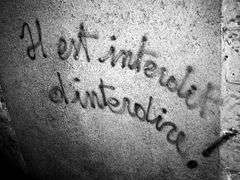
A few examples:[16]
- Il est interdit d'interdire ("It is forbidden to forbid").[17]
- Jouissez sans entraves ("Enjoy without hindrance").[17]
- Élections, piège à con ("Elections, a trap for idiots").[18]
- CRS = SS.[19]
- Je suis Marxiste—tendance Groucho. ("I'm a Marxist—of the Groucho tendency.")[20]
- Marx, Mao, Marcuse![21][22][23] Also known as "3M".[24]
- Cela nous concerne tous. ("This concerns all of us.")
- Soyez réalistes, demandez l'impossible. ("Be realistic, ask the impossible.")[25]
- "When the National Assembly becomes a bourgeois theater, all the bourgeois theaters should be turned into national assemblies." (Written above the entrance of the occupied Odéon Theater)[26]
- Sous les pavés, la plage! ("Under the paving stones, the beach.")
- "I love you!!! Oh, say it with paving stones!!!"[27]
- "Read Reich and act accordingly!" (University of Frankfurt; similar Reichian slogans were scrawled on the walls of the Sorbonne, and in Berlin students threw copies of Reich's The Mass Psychology of Fascism (1933) at the police).[28]
- Travailleurs la lutte continue[;] constituez-vous en comité de base. ("Workers the fight continues; form a basic committee.")[29][30]
Legacy
May 1968 is an important reference point in French politics, representing for some the possibility of liberation and for others the dangers of anarchy.[4] For some, May 1968 meant the end of traditional collective action and the beginning of a new era to be dominated mainly by the so-called new social movements.[31] In October 2017, President Emmanuel Macron announced that he planned to commemorate the May '68 riots for the 50th anniversary in 2018, saying about the riots "It helped liberate things within French society, and then it perhaps broke something that you need to protect in a society."[32]
Someone who took part in or supported this period of unrest is referred to as soixante-huitard - a term, derived from the French for "68", which has also entered the English language.
In popular culture
Cinema
- The François Truffaut film Baisers volés (1968) (in English: "Stolen Kisses"), takes place in Paris during the time of the riots and while not an overtly political film, there are passing references to and images of the demonstrations. The film captures the revolutionary feel of the time and makes perfectly understandable why Truffaut and Jean-Luc Godard would call for the cancellation of the Cannes Film Festival of 1968. Nothing could go on as it had in the past after May '68, and "Stolen Kisses" itself was a statement of that refusal.
- The André Cayatte film Mourir d'aimer (1971) (in English: "To die of love") is strongly based on the true story of Gabrielle Russier (1937-1969), a classics teacher (played by Annie Girardot) who committed suicide after being sentenced for having had an affair with one of her students during the events of May 68.
- The Jean-Luc Godard film Tout Va Bien (1972) examines the continuing class struggle within French society in the aftermath of May '68.
- Jean Eustache's 1973 film The Mother and the Whore, winner of the Cannes Grand Prix, references the events of May 1968 and explores the aftermath of the social movement.[33]
- The Claude Chabrol film Nada 1974 is based on symbolically on the events of May 1968.
- The Diane Kurys film Cocktail Molotov (1980) tells the story of a group of French friends heading towards Israel when they hear of the May events and decide to return to Paris.
- The Louis Malle film May Fools (1990) is a satiric depiction of the effect of French revolutionary fervor of May 1968 on small-town bourgeoisie.
- The Bernardo Bertolucci film The Dreamers (2003), based on the novel The Holy Innocents by Gilbert Adair, tells the story of an American university student in Paris during the protests.
- The Philippe Garrel film Regular Lovers (2005) is about a group of young people participating in the Latin Quarter of Paris barricades and how they continue their life one year after.
- In the spy-spoof, OSS 117: Lost in Rio, the lead character Hubert ironically chides the hippie students, saying, 'It's 1968. There will be no revolution. Get a haircut.'
- The Oliver Assayas film Something in the Air (2012) tells the story of a young painter and his friends who bring the revolution to their local school and have to deal with the legal and existential consequences.
- Le Redoutable, 2017 - bio-pic of Jean-Luc Godard, covering the 1968 riots/Cannes festival etc.
Music
- Many writings of French anarchist singer-songwriter Léo Ferré were inspired by those events. Songs directly related to May 1968 are: "L'Été 68", "Comme une fille" (1969), "Paris je ne t'aime plus" (1970), "La Violence et l'Ennui" (1971), "Il n'y a plus rien" (1973), "La Nostalgie" (1979). Many others Ferré's songs share the libertarian feel of that time.
- Claude Nougaro's song "Paris Mai" (1969).[34]
- The imaginary Italian clerk described by Fabrizio de André in his album Storia di un impiegato, is inspired to build a bomb set to explode in front of the Italian parliament by listening to reports of the May events in France, drawn by the perceived dullness and repetitivity of his life compared to the revolutionary developments unfolding in France.[35]
- The Refused song entitled "Protest Song '68" is about the May 1968 protests.[36]
- The Stone Roses's song "Bye Bye Badman", from their eponymous album, is about the riots. The album's cover has the tricolore and lemons on the front (which were used to nullify the effects of tear gas).[37]
- The music video for the David Holmes song "I Heard Wonders" is based entirely on the May 1968 protests and alludes to the influence of the Situationist International on the movement.[38]
- The Rolling Stones wrote the lyrics to the song "Street Fighting Man" (set to music of an unreleased song they had already written which had different lyrics) in reference to the May 1968 protests from their perspective, living in a "sleepy London town". The melody of the song was inspired by French police car sirens.[39]
- Vangelis released an album in France and Greece entitled Fais que ton rêve soit plus long que la nuit ("May you make your dreams longer than the night"), which was about the Paris student riots in 1968. The album contains sounds from the demonstrations, songs, and a news report. Vangelis would later become famous for film scores for such films as Chariots of Fire and Bladerunner.[40]
- Ismael Serrano's song "Papá cuéntame otra vez" ("Papa, tell me again") references the May 1968 events: "Papa, tell me once again that beautiful story, of gendarmes and fascists and long-haired students; and sweet urban war in flared trousers, and songs of the Rolling stones, and girls in miniskirts."[41]
- Caetano Veloso's song "É Proibido Proibir" takes its title from the May 1968 graffiti of the same name and was a protest song against the military regime that assumed power in Brazil in April 1964.[42]
- Many of the slogans from the May 1968 riots were included in Luciano Berio's seminal work Sinfonia.
- The band Orchid references the events of May 68 as well as Debord in their song "Victory Is Ours".
- The 1975's song "Love It If We Made It" makes reference to the Atelier Populaire's book made to support the events, 'Beauty Is In The Street'.
Literature
- The 1971 novel The Merry Month of May by James Jones tells a story of (fictional) American expatriates caught up in Paris during the events.
- The Holy Innocents is a 1988 novel by Gilbert Adair with a climactic finale on the streets of 1968 Paris. The novel was adapted for the screen as The Dreamers (2003).
Art
Video games
- The 2010 game Metal Gear Solid: Peace Walker had a briefing file that described the May 1968 protests and their influence on the character Cécile Cosima Caminades, a Frenchwoman.
See also
- 2005 civil unrest in France
- 2006 youth protests in France
- Anarchism in France
- Autonomism
- Beauty Is in the Street, a 2011 book of posters from May 1968
- Council for Maintaining the Occupations
- Enragés
- On the Poverty of Student Life
- Protests of 1968
- Report on the Construction of Situations
- Situationist International
- Socialisme ou Barbarie
- Sorbonne Occupation Committee
- Taksim Gezi Park protests
References
- 1 2 3 4 5 "Situationist International Online".
- ↑ "Mai 68 - 40 ans déjà".
- ↑ DeRoo, Rebecca J. (2014). The Museum Establishment and Contemporary Art: The Politics of Artistic Display in France after 1968. Cambridge University Press. ISBN 9781107656918.
- 1 2 Erlanger, Steven (29 April 2008). "May 1968 - a watershed in French life". New York Times. Retrieved 31 August 2012.
- 1 2 3 4 5 Mendel, Arthur P. (January 1969). "Why the French Communists Stopped the Revolution". The Review of Politics. 31 (1): 3–27. doi:10.1017/s0034670500008913. JSTOR 1406452.
- ↑ Rotman, pp. 10–11; Damamme, Gobille, Matonti & Pudal, ed., p. 190.
- ↑ Damamme, Gobille, Matonti & Pudal, ed., p. 190.
- ↑ "Michel Rocard :". Le Monde.fr.
- 1 2 3 4 5 6 7 8 9 10 11 12 13 Dogan, Mattei (1984). "How Civil War Was Avoided in France". International Political Science Review / Revue internationale de science politique. 5 (3): 245–277. doi:10.1177/019251218400500304. JSTOR 1600894.
- ↑ 1944-, Viénet, René, (1992). Enragés and situationists in the occupation movement, France, May '1968. New York: Autonomedia. p. 91. ISBN 0936756799. OCLC 27424054.
- ↑ Singer, Daniel (2002). Prelude to Revolution: France in May 1968. South End Press. pp. 184–185. ISBN 9780896086821.
- ↑ Derrida, Jacques (1991) "A 'Madness' Must Watch Over Thinking", interview with Francois Ewald for Le Magazine Litteraire, March 1991, republished in Points...: Interviews, 1974-1994 (1995).pp.347-9
- 1 2 3 4 Singer, Daniel (2002). Prelude to Revolution: France in May 1968. South End Press. pp. 195, 198–201. ISBN 978-0-89608-682-1.
- ↑ Dogan, Mattéi (2005). Political Mistrust and the Discrediting of Politicians. Brill. p. 218. ISBN 9004145303.
- ↑ "Lycos". Archived from the original on 22 April 2009.
- ↑ "Graffiti de Mai 1968".
- 1 2 Éditions Larousse. "Encyclopédie Larousse en ligne - événements de mai 1968". Retrieved 29 September 2015.
- ↑ Par Sylvain BoulouqueVoir tous ses articles (28 February 2012). "Pour la gauche radicale, "élections, piège à cons" ?". L'Obs. Retrieved 29 September 2015.
- ↑ "CRS = SS". Retrieved 29 September 2015.
- ↑ Lejeune, Anthony (2001). The Concise Dictionary of Foreign Quotations. Taylor & Francis. p. 74. ISBN 0953330001. Retrieved 1 December 2010.
- ↑ Martin Jay (1996). Dialectical Imagination. p. xii.
- ↑ Mervyn Duffy (2005). How Language, Ritual and Sacraments Work: According to John Austin, Jürgen Habermas and Louis-Marie Chauvet. Gregorian Biblical BookShop. p. 80. ISBN 9788878390386. Retrieved 9 March 2015.
- ↑ Anthony Elliott (2014). Contemporary Social Theory: An Introduction. p. 66. Retrieved 9 March 2015.
- ↑ Franzosi, Roberto (March 2006). "Power and Protest: Global Revolution and the Rise of Détente by Jeremi Suri". American Journal of Sociology. The University of Chicago Press. 111 (5): 1589. doi:10.1086/504653. JSTOR 10.1086/504653.
- ↑ Watzlawick, Paul (1993). The Language of Change: Elements of Therapeutic Communication. W. W. Norton & Company. p. 83. ISBN 9780393310207. Retrieved 1 December 2010.
- ↑ Revolutionary rehearsals. Barker, Colin, 1939-. Chicago, Il.: Haymarket Books. 2002. p. 23. ISBN 9781931859028. OCLC 154668230.
- ↑ Ken Knabb, ed. (2006). Situationist International Anthology. Bureau Of Public Secrets. ISBN 9780939682041.
- ↑ Turner, Christopher (2011). Adventures in the Orgasmatron. HarperCollins, pp. 13–14.
- ↑ https://www.google.com/search?biw=1440&bih=738&ei=omA8W5HsGsaKjwT405foDg&q=travailleurs+la+lutte+continue&oq=travailleurs+la+lutte+continue&gs_l=psy-ab.3..33i160k1.429.7026.0.7316.34.33.1.0.0.0.146.3024.22j9.31.0..2..0...1.1.64.psy-ab..2.28.2649...0j0i131k1j0i131i67k1j0i10k1j0i19k1j0i22i30i19k1j0i22i30k1j33i22i29i30k1j33i21k1.0.f8JFzpzyQQI
- ↑ https://www.gerrishfineart.com/mai-68,-%27travailleurs-la-lutte-continue%27,-screenprint,-1968~1795
- ↑ Staricco, Juan Ignacio (2012) https://www.scribd.com/doc/112409042/The-French-May-and-the-Roots-of-Postmodern-Politics
- ↑ "Macron plans to commemorate May '68 riots". Retrieved 2017-10-27.
- ↑ Pierquin, Martine (July 2014). "The Mother and the Whore". Senses of Cinema. Retrieved 1 June 2017.
- ↑ Riding, Alan (2004-03-22). "Claude Nougaro, French Singer, Is Dead at 74". The New York Times. ISSN 0362-4331. Retrieved 2015-11-23.
- ↑ Giannini, Stefano (2005). "Storia di un impiegato di Fabrizio De André". La Riflessione. pp. 11–16.
- ↑ Kristiansen, Lars J.; Blaney, Joseph R.; Chidester, Philip J.; Simonds, Brent K. (2012-07-10). Screaming for Change: Articulating a Unifying Philosophy of Punk Rock. Lexington Books. ISBN 978-0-7391-4276-9.
- ↑ John Squire. "Bye Bye Badman". John Squire. Retrieved 3 November 2009.
- ↑ Cole, Brendan (2008-08-25). "David Holmes Interview" (Articles). RTE.ie. Retrieved 2015-11-23.
- ↑ "I wanted the [sings] to sound like a French police siren. That was the year that all that stuff was going on in Paris and in London. There were all these riots that the generation that I belonged to, for better or worse, was starting to get antsy. You could count on somebody in America to find something offensive about something — you still can. Bless their hearts. I love America for that very reason." N. P. R. Staff. "Keith Richards: 'These Riffs Were Built To Last A Lifetime'". NPR.org. Retrieved 2015-11-23.
- ↑ Griffin, Mark J. T. (2013-03-13). Vangelis: The Unknown Man. Lulu Press, Inc. ISBN 978-1-4476-2728-9.
- ↑ Mucientes, Esther. "MAYO DEL 68: La música de la revolución". elmundo.es. Retrieved 2015-11-23.
- ↑ Christopher, Dunn (2001). Brutality Garden: Tropicalia and the Emergence of a Brazilian Counterculture. University of North Carolina Press. p. 135.
Sources
Further reading
- Abidor, Mitchell. May Made Me. An Oral History of the 1968 Uprising in France (interviews).
- Adair, Gilbert. The Holy Innocents (novel).
- Bourg, Julian. From Revolution to Ethics: May 1968 and Contemporary French Thought.
- Casevecchie, Janine. MAI 68 en photos:,Collection Roger-Viollet, Editions du Chene - Hachette Livre, 2008.
- Castoriadis, Cornelius with Claude Lefort and Edgar Morin. Mai 1968: la brèche.
- Cliff, Tony and Ian Birchall. France – the struggle goes on. Full text at marx.org
- Cohn-Bendit, Daniel. Obsolete Communism: The Left-Wing Alternative.
- Dark Star Collective. Beneath the Paving Stones: Situationists and the Beach, May 68.
- DeRoo, Rebecca J. The Museum Establishment and Contemporary Art: The Politics of Artistic Display in France after 1968.
- Feenberg, Andrew and Jim Freedman. When Poetry Ruled the Streets.
- Ferlinghetti, Lawrence. Love in the Days of Rage (novel).
- Gregoire, Roger and Perlman, Fredy. Worker-Student Action Committees: France May '68. PDF of the text
- Harman, Chris. The Fire Last Time: 1968 and After. London: Bookmarks, 1988.
- Jones, James. The Merry Month of May (novel).
- Knabb, Ken. Situationist International Anthology.
- Kurlansky, Mark. 1968: The Year That Rocked The World.
- Marcus, Greil. Lipstick Traces: A Secret History of the 20th Century.
- Emile Perreau-Saussine, "Liquider mai 68?", in Les droites en France (1789–2008), CNRS Editions, 2008, p. 61-68, PDF
- Plant, Sadie. The Most Radical Gesture: The Situationist International in a Postmodern Age.
- Quattrochi, Angelo; Nairn, Tom (1998). The Beginning of the End. Verso Books. ISBN 978-1859842904.
- Ross, Kristin. May '68 and its Afterlives.
- Schwarz, Peter. '1968: The general strike and the student revolt in France'. 28 May 2008. Retrieved 12 June 1010. World Socialist Web Site.
- Seale, Patrick and Maureen McConville. Red Flag/Black Flag: French Revolution 1968.
- Seidman, Michael. The Imaginary Revolution: Parisian Students and Workers in 1968 (Berghahn, 2004).
- Singer, Daniel. Prelude To Revolution: France In May 1968.
- Staricco, Juan Ignacio. The French May and the Shift of Paradigm of Collective Action.
- Touraine, Alain. The May Movement: Revolt and Reform.
External links
| Wikimedia Commons has media related to May 1968 protests in France. |
Archival collections
- Guide to the Paris Student Revolt Collection. Special Collections and Archives, The UC Irvine Libraries, Irvine, California.
- Paris 1968 Posters Digital Collections | Victoria University Library in the University of Toronto
- Paris, Posters of a Revolution Collection Special Collections | Victoria University Library in the University of Toronto
- May Events Archive of Documents
- Paris May-June 1968 Archive at marxists.org
